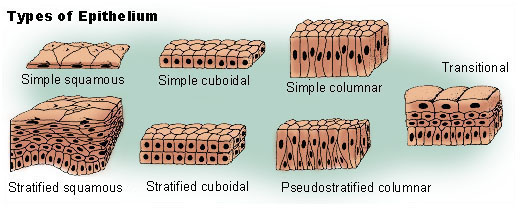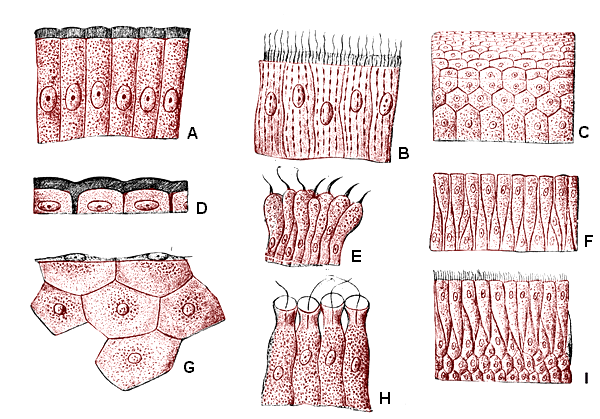Epithelium
|
WikiDoc Resources for Epithelium |
|
Articles |
|---|
|
Most recent articles on Epithelium |
|
Media |
|
Evidence Based Medicine |
|
Clinical Trials |
|
Ongoing Trials on Epithelium at Clinical Trials.gov Clinical Trials on Epithelium at Google
|
|
Guidelines / Policies / Govt |
|
US National Guidelines Clearinghouse on Epithelium
|
|
Books |
|
News |
|
Commentary |
|
Definitions |
|
Patient Resources / Community |
|
Patient resources on Epithelium Discussion groups on Epithelium Patient Handouts on Epithelium Directions to Hospitals Treating Epithelium Risk calculators and risk factors for Epithelium
|
|
Healthcare Provider Resources |
|
Causes & Risk Factors for Epithelium |
|
Continuing Medical Education (CME) |
|
International |
|
|
|
Business |
|
Experimental / Informatics |
Editor-In-Chief: C. Michael Gibson, M.S., M.D. [1]
Overview

In biology and medicine, epithelium is a tissue composed of a layer of cells. Epithelium lines both the outside (skin) and the inside cavities and lumen of bodies. The outermost layer of our skin is composed of dead stratified squamous, keratinized epithelial cells.
Mucous membranes lining the inside of the mouth, the esophagus, and part of the rectum are lined by nonkeratinized stratified squamous epithelium. Other, open to outside body cavities are lined by simple squamous or columnar epithelial cells.
Other epithelial cells line the insides of the lungs, the gastrointestinal tract, the reproductive and urinary tracts, and make up the exocrine and endocrine glands. The outer surface of the cornea is covered with fast-growing, easily-regenerated epithelial cells.
Functions of epithelial cells include secretion, absorption, protection, transcellular transport, sensation detection, and selective permeability.
Endothelium (the inner lining of blood vessels, the heart, and lymphatic vessels) is a specialized form of epithelium. Another type, Mesothelium, forms the walls of the pericardium, pleurae, and peritoneum.
In humans, epithelium is classified as a primary body tissue, the other ones being connective tissue, muscle tissue and nervous tissue.
Classification
Epithelial cells are classified by the following three factors:
- Shape
- Stratification
- Specializations
Shape
- Squamous: All Squamous cells are flat cells with an irregular flattened shape. A one-cell layer of simple squamous epithelium forms the alveoli of the respiratory membrane, and the endothelium of capillaries, and is a minimal barrier to diffusion. Other places where squamous cells can be found include the filtration tubules of the kidneys, and the major cavities of the body. These cells are relatively inactive metabolically, and are associated with the diffusion of water, electrolytes, and other substances.
- Cuboidal: As the name suggests, these cells have a shape similar to a cube, meaning its width is the same size as its height. The nuclei of these cells are usually located in the center.
- Columnar: These cells are taller than they are wide. Simple columnar epithelium is made up of a single layer of cells that are longer than they are wide. The nucleus is also closer to the base of the cell. The small intestine is a tubular organ lined with this type of tissue. Unicellular glands called goblet cells are scattered throughout the simple columnar epithelial cells and secrete mucus. The free surface of the columnar cell has tiny hairlike projections called microvilli. They increase the surface area for absorption.
- Transitional: This is a specialized type of epithelium found lining organs that can stretch, such as the urothelium that lines the bladder and ureter of mammals. Since the cells can slide over each other, the appearance of this epithelium depends on whether the organ is distended or contracted: if distended, it appears as if there are only a few layers; when contracted, it appears as if there are several layers.
Stratification
- Simple: There is a single layer of cells.
- Stratified: More than one layer of cells. The superficial layer is used to classify the layer. Only one layer touches the basal lamina. Stratified cells can usually withstand large amounts of stress.
- Pseudostratified with cilia: This is used mainly in one type of classification (pseudostratified columnar epithelium). There is only a single layer of cells, but the position of the nuclei gives the impression that it is stratified. If a specimen looks stratified, but you can identify cilia, the specimen is pseudostratified ciliated epithelium since stratified epithelium cannot have cilia but may be very rarely found in fetal oesophagus. A cell that contains hairs will be around ten times stronger than a regular cell
Specializations
- Keratinized cells contain keratin (a cytoskeletal protein). While keratinized epithelium occurs mainly in the skin, it is also found in the mouth and nose, providing a tough, impermeable barrier.
- Ciliated cells have apical plasma membrane extensions composed of microtubules capable of beating rhythmically to move mucus or other substances through a duct. Cilia are common in the respiratory system and the lining of the oviduct.
Headline text
Examples
| System | Tissue | Epithelium | Subtype |
| circulatory | blood vessels | Simple squamous | endothelium |
| digestive | ducts of submandibular glands | Stratified columnar | - |
| digestive | attached gingiva | Stratified squamous, keratinized | - |
| digestive | dorsum of tongue | Stratified squamous, keratinized | - |
| digestive | hard palate | Stratified squamous, keratinized | - |
| digestive | esophagus | Stratified squamous, non-keratinised | - |
| digestive | stomach | Simple columnar, non-ciliated | - |
| digestive | small intestine | Simple columnar, non-ciliated | - |
| digestive | large intestine | Simple columnar, non-ciliated | - |
| digestive | rectum | Stratified squamous, non-keratinised | - |
| digestive | anus | Stratified squamous, keratinised | - |
| digestive | gallbladder | Simple columnar, non-ciliated | - |
| endocrine | thyroid follicles | Simple cuboidal | - |
| nervous | ependyma | Simple cuboidal | - |
| lymphatic | lymph vessel | Simple squamous | endothelium |
| integumentary | skin - dead superficial layer | Stratified squamous, keratinized | - |
| integumentary | sweat gland ducts | Stratified cuboidal | - |
| integumentary | mesothelium of body cavities | Simple squamous | - |
| reproductive - female | ovaries | Simple cuboidal | germinal epithelium (female) |
| reproductive - female | Fallopian tubes | Simple columnar, ciliated | - |
| reproductive - female | uterus | Simple columnar, ciliated | - |
| reproductive - female | endometrium | Simple columnar | - |
| reproductive - female | cervix (endocervix) | Simple columnar | - |
| reproductive - female | cervix (ectocervix) | Stratified squamous, non-keratinised | - |
| reproductive - female | vagina | Stratified squamous, non-keratinised | - |
| reproductive - female | labia majora | Stratified squamous, keratinised | - |
| reproductive - male | tubuli recti | Simple cuboidal | germinal epithelium (male) |
| reproductive - male | rete testis | Simple cuboidal | - |
| reproductive - male | ductuli efferentes | Pseudostratified columnar | - |
| reproductive - male | epididymis | Pseudostratified columnar, with stereocilia | - |
| reproductive - male | vas deferens | Pseudostratified columnar | - |
| reproductive - male | ejaculatory duct | Simple columnar | - |
| reproductive - male (gland) | bulbourethral glands | Simple columnar | - |
| reproductive - male (gland) | seminal vesicle | Pseudostratified columnar | - |
| respiratory | oropharynx | Stratified squamous, non-keratinised | - |
| respiratory | larynx | Pseudostratified columnar, ciliated | respiratory epithelium |
| respiratory | trachea | Pseudostratified columnar, ciliated | respiratory epithelium |
| respiratory | respiratory bronchioles | Simple cuboidal | - |
| sensory | cornea | Stratified squamous, non-keratinised | corneal epithelium |
| sensory | nose | Pseudostratified columnar | olfactory epithelium |
| urinary | kidney - proximal convoluted tubule | Simple columnar, ciliated | - |
| urinary | kidney - ascending thin limb | Simple squamous | - |
| urinary | kidney - distal convoluted tubule | Simple columnar, non-ciliated | - |
| urinary | kidney - collecting duct | Simple cuboidal | - |
| urinary | renal pelvis | Transitional | urothelium |
| urinary | ureter | Transitional | urothelium |
| urinary | urinary bladder | Transitional | urothelium |
| urinary | prostatic urethra | Transitional | urothelium |
| urinary | membranous urethra | Pseudostratified columnar, non-ciliated | - |
| urinary | penile urethra | Pseudostratified columnar, non-ciliated | - |
| urinary | external urethral orifice | Stratified squamous | - |
Cell junctions
A cell junction is a structure within a tissue of a multicellular organism. Cell junctions are especially abundant in epithelial tissues. They consist of protein complexes and provide contact between neighbouring cells, between a cell and the extracellular matrix, or they built up the paracellular barrier of epithelia and control the paracellular transport.
Secretory epithelia
As stated above, secretion is one major function of epithelial cells. Glands are formed from the invagination / infolding of epithelial cells and subsequent growth in the underlying connective tissue. There are two major classification of glands: endocrine glands and exocrine glands. Endocrine glands are glands that secrete their product directly onto a surface rather than through a duct. This group contains the glands of the Endocrine system
Embryology
Generally, there are epithelial tissues deriving from all of the embryological germ layers:
- from ectoderm (e.g., the epidermis);
- from endoderm (e.g., the lining of the gastrointestinal tract);
- from mesoderm (e.g., the inner linings of body cavities).
However, it is important to note that pathologists do not consider endothelium and mesothelium (both derived from mesoderm) to be true epithelium. This is because such tissues present very different pathology. For that reason, pathologists label cancers in endothelium and mesothelium sarcomas, while true epithelial cancers are called carcinomas. Also, the filaments that support these mesodermally derived tissues are very distinct. Outside of the field of pathology, the idea that epithelium arise from all three germ layers is generally accepted
Additional images
Links
References
- Molecular Biology of the Cell, 4th edition, Alberts et al., 2002
bg:Епителна тъкан
cs:Epitelová tkáň
da:Epitel
de:Epithel
eu:Epitelio ehun
ko:상피세포
id:Jaringan epitel
it:Tessuto epiteliale
he:אפיתל
lv:Epitēlijaudi
lt:Epitelinis audinys
nl:Epitheel
no:Epitel
nn:Epitel
sk:Epitel
sl:Krovno tkivo
sr:Епителско ткиво
fi:Epiteelikudos
sv:Epitel
th:เนื้อเยื่อบุผิว
tg:Бофтаи эпителӣ
uk:Епітелій
